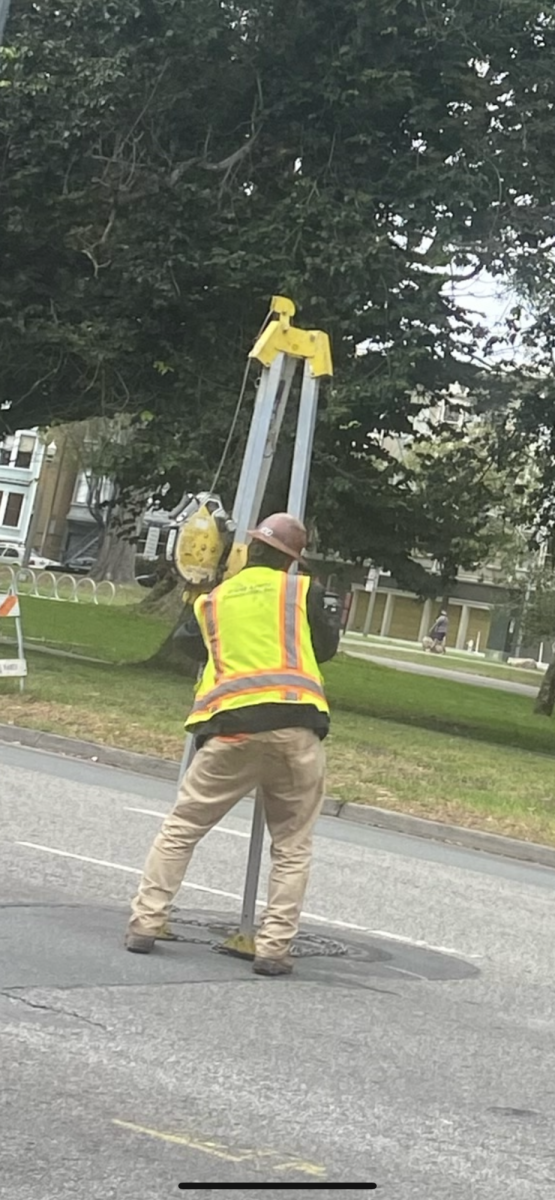Construction spanning nine blocks in front of Urban’s Oak Street campus had been releasing a chemical called styrene into the air and nearby buildings. This construction ran from May 2023 to September 2023. Although untested on humans, styrene has been proven to cause cancer in animals.
In an effort to replace sewer pipes around California ranging from 90 to 150 years old, the San Francisco Public Utilities Commission (SFPUC) has contracted D’Arcy & Harty Construction Inc. to implement the San Francisco Water Power Sewer (SFWPS) project. According to the SFPUC website, the goal of the project is to maintain the water, power and sewer systems around the state so they continue to run reliably and efficiently. The project includes 30-plus construction sites in San Francisco alone, and is scheduled for completion in May of 2024.
Since 2013, San Francisco has been using a method called cured-in-place piping (CIPP) to upgrade older sewage. The appeal is its clean-cut execution; other methods for sewer rehabilitation tear streets up, take longer to complete and are much louder.
CIPP is a method where workers inflate a pipe lining made of styrene-based resins inside of an existing pipe. When air is pumped into the lining to mold to the host pipe, some of the lining’s styrene content vaporizes and escapes into the air and into sewer laterals. Through the sewer laterals, which are the pipes that connect buildings’ plumbing to the city’s main sewer system, the styrene vapor can lead directly into buildings near the site.
Vaporized styrene produces an odor that some have been smelling around campus. “It is almost like gas and a burning smell. It is nasty,” said Lucy Bone ‘26. “I smelled it around Urban when I was here over the summer.”
Beyond the odor, styrene likely poses harm to the human body. In 2018, the World Health Organization (WHO) classified styrene as a Group 2A carcinogen, meaning that it can cause cancer in animals.
According to the Centers for Disease Control and Prevention (CDC), ingesting or inhaling large amounts of styrene can result in styrene sickness, causing the neurological system to slow. The CDC also explains that in styrene-inhalation trials, animals have displayed hearing loss, alterations to the lining of the nose and destruction of the liver. “However, animals may be more sensitive than humans to the nose and liver effects,” they wrote. According to the Agency for Toxic Substances and Disease Registry (ATSDR), styrene can also have adverse reproductive effects on animals.
Since styrene may pose health threats to San Franciscans, contractors are required to take preventative measures to alleviate the risk of styrene release. In an email exchange with The Urban Legend, Chris Colwick, communications manager of the Wastewater Capital Program, wrote, “The plans [use] measures such as fans, blowers and carbon filtration to reduce airborne styrene levels.”
“The CIPP process may emit styrene at certain points during the work,” wrote Elsa Eder, public information officer for the SFPUC, in an email exchange with Science Teacher Geoff Ruth and The Urban Legend. “[However,] I’m happy to report that data is showing levels [of styrene] far below the California Department of Public Health’s (CDP) established acceptable levels.” Eder mentioned that at low enough levels, styrene is safe: it shows up in foods such as coffee, strawberries and cinnamon.
However, Ruth disagrees with the CDP’s threshold for unsafe styrene levels, and believes that their guidelines create a false sense of security. “The vast majority of toxins are innocuous at very low concentrations and become toxic at high enough concentrations … The idea that it’s safe because styrene is found in low concentrations in food items is preposterous because a basic idea of toxicology is that the dose makes the poison,” Ruth said.
In an interview with the Public Interest Research Group (PIRG) about the effects of styrene gas, Kara Cook-Schultz, toxics director for PIRG, said, “Now that WHO has shown that this stuff is a probable carcinogen, it’s time to get it off the shelves and out of our homes.”
The SFPUC has been sending informational pamphlets to nearby residents, disclosing what to expect from the construction, including parking disruption, noise and odor. Despite acknowledging the smell and even recommending that residents cover their drains with a wet towel, styrene is not mentioned in the information provided.
Some families are not even receiving the notices, mention of styrene or not. “I live really close to some of the construction … [and my household] has never received anything,” said Bone.
Ruth said, “I understand that ripping up the streets is disruptive and inconvenient. But until the safety impacts of CIPP are better understood, that seems worth it to me.”


